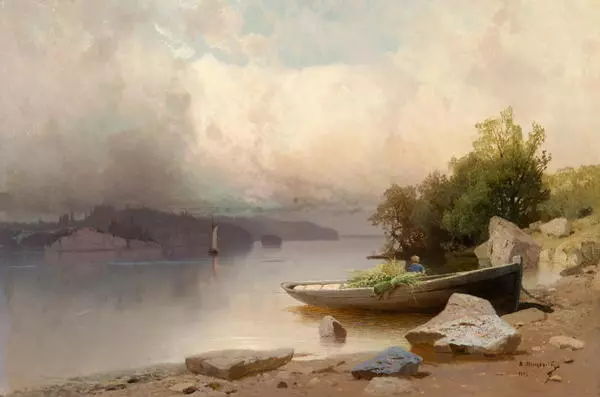Arseny Ivanovich Meshchersky was a Russian painter, a typical academic landscape artist of the second half of the 19th century, known for his depictions of nature in Southern and Northern Russia, Crimea and the Caucasus. Meshchersky was a student of the Swiss landscape painter Alexandre Calame, from whom he borrowed techniques, and then developed his own style of landscape painting, which became the hallmark of the artist.
Information about Arseny Ivanovich’s parents has not been preserved, but probably the artist belonged to the noble family of Meshchersky. In 1854–1857, he was a non-matriculated student at the Imperial Academy of Arts, where he studied under the guidance of Fyodor Bruni, Socrates Vorobyov, and Timofey Neff. For the painting “Swiss View” presented at the Academic Exhibition of 1859, he received a Grand Gold Medal, the title of a class artist and the right to travel abroad on a pension from the Academy. In 1860, Meshchersky traveled to Switzerland at government expense, visiting Crimea, Turkey, Greece and Italy along the way. In 1884, Arseny Ivanovich received the title of professor at the Imperial Academy of Arts for the painting “At Forest Lake.” In 1886, he was awarded the Order of Saint Anna of the third class “for special works in the artistic field.”
Meshchersky was very popular in the art world of St. Petersburg. He was best at mountain landscapes and winter motifs. The painting “Winter Landscape” presented in the museum’s collection is an excellent example of the artist’s high skill. The distinctive elements in Arseny Ivanovich’s landscapes are sunrises and sunsets, snow peaks, dark gorges and frosty haze. In the painting, in a clearing covered with snow, near a frozen river, there are large blocks of crushed ice. Further to the right stands a bridge, and in the depths there is a forest covered with frost. Three children’s figures are placed near the bridge. The landscape accurately conveys the atmosphere of a cold winter day. There are no sharp contrasts or deliberate lighting effects on the canvas, but nature in Meshchersky’s landscapes is solemn and majestic. The landscape is designed in silvery tones and enlivened by greenish reflexes.
The painting entered the collection of the Voronezh
Regional Art Museum named after Ivan Kramskoy from the Museum of Antiquities
and Fine Arts of Voronezh State University in 1933.




